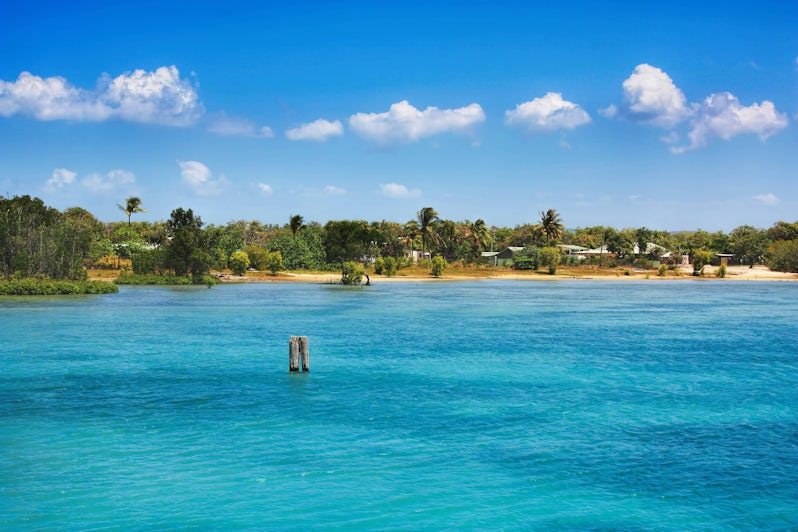
Vaccinations for Cruises: What's Required Where


It's easy to feel safe on a cruise, especially if you stick to well-touristed areas and don't eat or drink local foods in port. In this way, you might feel one step removed from exposure to communicable diseases commonly found in the countries you visit by ship. That feeling of safety is justified to a certain extent, but there are still risks that might require you to get a few jabs before you leave home.
For example, adventurous outdoor activities carry a risk from insect and animal bites in some locations, as do tattoos and piercings almost anywhere. Regardless of what you plan to do in port, there may be vaccines that are required for entry into certain countries, even when you arrive by cruise ship. You should plan to get vaccines that are required and/or recommended at least a month before your travel dates.
In addition to vaccines required by individual countries, the U.S. Centers for Disease Control and Prevention (CDC) issues guidelines for vaccinations that are recommended for travel, with special information for cruisers, as well as for children and travelers with compromised immune systems.
At the top of its list for travelers to all destinations are vaccinations for measles (MMR). Flu shots and routine childhood immunizations, including the diphtheria-pertussis-tetanus vaccine (DPT), varicella (chickenpox) vaccine, and polio vaccine are all recommended by the CDC before travel. (Because these are standard for all travelers, we will not repeat them in the individual listings below.)
Here's a rundown of which vaccines are required where, plus those you may want to consider before your next cruise. Keep in mind that cruise lines might not notify you of required vaccines before sailing.
On This Page
Africa

Required: Yellow fever is of primary concern throughout Africa. Many countries in the central and the western side of the continent are considered high risk for exposure, and the vaccine is required for all cruisers visiting those countries, including The Gambia, Ghana, Ivory Coast and Angola.
On the east coast, the risk is lower and the vaccine is only required for those who have visited high-risk areas first. If your cruise only visits the east coast and you do not travel far inland in any of those countries, no vaccine is needed. For example, if your cruise stops in Cameroon, Ghana or the Gambia you will need the vaccine in those and subsequent countries even though coastal Kenya, Mozambique and South Africa are considered low risk.
Recommended: In addition to yellow fever in the high-risk countries, the CDC recommends typhoid and hepatitis A vaccines for most travelers to Africa, as well as malaria prevention medications. Additional vaccines to discuss with your doctor include meningitis for travel during the drier season of June–December and hepatitis B for travelers who may encounter contaminated needles or medical equipment.
Cholera vaccine is recommended only to travelers to specific areas in Africa with active outbreaks. The CDC's up-to-date cholera information is the best place to find where those outbreaks have occurred.
The rabies vaccine is recommended for some travelers, specifically those who will be spending a great deal of time outside participating in hiking, biking and caving where animal bites are possible.
Asia
Required: Most Asian countries have a relatively low risk of yellow fever transmission, but many are quite strict in requiring proof of vaccination from travelers who have been to African or South American countries considered high risk.
India, for example, requires a six-day quarantine for travelers who don't have proof of vaccination if they have visited a high-risk region in the six days before arrival in India. The quarantine is also required even if travelers themselves did not visit a high-risk area but arrive on a cruise ship that made a port of call in a high-risk country in the 30 days prior and has not been disinsected according to the standards of the World Health Organization. (The process of using pesticides to stop the transmission of yellow fever is common on both aircraft and ships leaving the high-risk area.)
As strict as that sounds, cruise lines would be aware of the restriction, with most avoiding such a route. Cruise lines that do schedule sailings in these exotic areas do so knowingly and take all necessary measures between ports of call.
For example, we found at least one cruise on Seabourn that makes port calls in The Gambia, Senegal, Ghana, Ivory Coast and Angola (all of which are high-risk areas) before landing in India inside the 30-day window. A spokesman for the Seabourn Hotel Operations team confirmed that the ship follows all precautions to kill mosquitoes (which transmit yellow fever) and eliminate their breeding grounds (standing stagnant water), such as additional cleaning of outside decks and adding insect-trapping filters to air-conditioning systems.
In general, if you are visiting a country at high risk for yellow fever, you need the vaccine to enter that country, so you won't have a problem with subsequent visits in Asia, unless you forget your proof of vaccination. Even that is not a likely scenario because in most cases the cruise line will require the proof at the time you initially board the ship.
Recommended: Yellow fever vaccine is not recommended for visits to Asia. In addition to the standard CDC recommendations for all travelers, talk to your doctor about hepatitis A and typhoid, both of which are recommended throughout Asia for most travelers.
Malaria prevention medications are recommended for tropical and subtropical areas of Asia, as is vaccination for Japanese encephalitis, particularly if you will be spending a great deal of time outdoors where there are mosquitoes in warm seasons.
Rabies vaccine is recommended for those who participate in outdoor adventure activities where animal bites may occur.
Australia, New Zealand and the South Pacific

Required: Cruisers traveling to Australia and many tropical islands of the South Pacific who have visited or transited through areas with a high risk of yellow fever transmission within six days before arrival are required to have vaccination certificates for yellow fever. The high-risk areas are all in Africa and South America, making it an unlikely occurrence for most cruisers. The exception would be if you are on a land-based tour that includes any of the high-risk countries before traveling to Australia.
Recommended: In addition to the standard vaccine recommendations, the CDC recommends vaccines for hepatitis A if you will be eating and drinking in ports in Australia, New Zealand and the South Pacific, and hepatitis B if you will be exposed to needles through tattoos, piercings, drug use or medical procedures.
Rabies is present in Australian bats, but the risk of exposure is low for most cruisers.
Exposure to Japanese encephalitis is possible in remote areas of far Northern Australia, including the area near Thursday Island. Vaccination is recommended primarily for those planning to spend a great deal of time outdoors where they would be exposed to infected mosquitoes.
Caribbean
Required: The risk of yellow fever transmission is relatively low throughout the Caribbean, other than in Trinidad and Tobago. Even there, the vaccine is not required unless the traveler has recently been to another yellow fever high-risk area. The same requirement applies in many island nations in the region.
That means that yellow fever vaccinations for Caribbean cruises are not required if your cruise is wholly contained within the U.S., Mexico and the Caribbean, and you have not visited South America before arrival in the Caribbean. The obvious exception would be if your cruise stops anywhere with the requirement after visiting Trinidad and Tobago. The confusing factor here is that the CDC specifically does not recommend the vaccine in Trinidad and Tobago for cruise passengers.
Here's an example of a Caribbean cruise that could trigger a yellow fever vaccination requirement: If your ship stops at Charlotteville, Tobago (where the vaccine is not mandatory, or even recommended) and then stops in Bonaire, Grenada or St. Lucia, among others, the vaccination would become necessary. And, while vaccine certificates may or may not be checked upon arrival in those countries by cruise ship, the fact that it is required means authorities can prevent unvaccinated passengers from leaving the ship if they choose to do so.
Recommended: The CDC recommends hepatitis A for most travelers. The typhoid vaccine is also recommended in the Caribbean for most travelers. Hepatitis B vaccine is recommended for travelers who may come into contact with contaminated needles, so if you plan on getting a souvenir tat in the Caribbean, plan on getting a vaccination ahead of time.
Cholera vaccine is only recommended in areas with active outbreaks, which currently does not include any cruise ports, despite past outbreaks in both the Dominican Republic and Haiti.
Europe

Required: No vaccines are required for cruising through Europe.
Recommended: In addition to routine vaccinations, the CDC recommends vaccinations for hepatitis A if you plan to eat and drink in port, for hepatitis B if you will be exposed to needles and for rabies if you will be exposed to wildlife, particularly to bats in caves.
Central and South America
Required: Many countries in South America require proof of yellow fever vaccination for entry if you are arriving from an area known for a high-risk rate of transmission. Cruising between countries in the region can be tricky. For example, Brazil does not currently require the vaccination for entry, but if your cruise stops in Brazil, followed by South American ports in tropical areas of the continent, proof of vaccination will be required in the subsequent countries.
A similar situation applies to the Central American countries of Panama, Costa Rica, Nicaragua, Honduras, El Salvador and Guatemala, all of which require vaccination if your ship stopped in a port within a high-risk area first. We studied common cruise routes and found examples of east-to-west Panama Canal cruises that stop in Cartagena before cruising through the canal and on to multiple Central American ports. The stop in Colombia would trigger the mandatory vaccination in subsequent ports of call.
Recommended: Regardless of each country's requirements for entry, the CDC recommends the yellow fever vaccine throughout most of the tropical and subtropical portions of the continent. These include most of Brazil and Colombia and inland areas of Panama, east of the canal. Exceptions are higher elevations, plus Uruguay, Chile, coastal Ecuador (including the Galapagos), coastal Peru and Argentina.
For cruisers, that means the vaccine is recommended for Amazon sailings, cruises that stop in Rio de Janeiro and Sao Paulo, and for cruises with ports of call in Colombia. Vaccinations are not recommended for stops at the Venezuelan islands of Isla Margarita or Las Roques, nor for Panama City or trans-canal cruises.
The CDC's information page on yellow fever in South America lists high-risk countries.
Beyond yellow fever and standard childhood vaccines, the CDC recommends hepatitis A and typhoid vaccines for most travelers. Hepatitis B is recommended for travelers who may encounter contaminated needles. Malaria prevention medications may be needed for travelers who will be spending a great deal of time outside in rural areas at lower elevations where mosquitoes are prevalent, particularly on Amazon cruises.